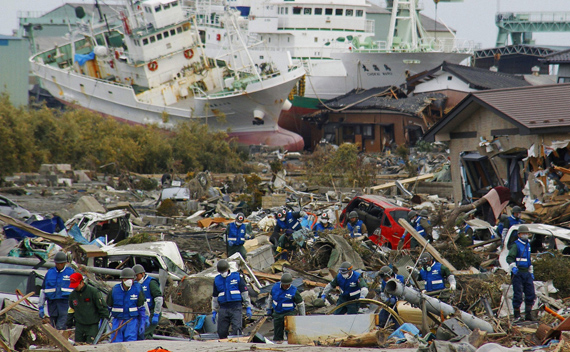A Stunned Japan Turns to Its Military
More on:

[Click here for information on how to locate friends and family in Japan, and here for how you can help]
For much of the postwar period, the Japanese Self Defense Force (SDF) has remained in the background of national life. Post-war sensitivities about pre-war militarism left little room for the SDF to vaunt its capabilities, or its bravery.
But today, as the country faces a complex and simultaneous series of crises, Japan’s military has emerged as the nation’s most relied upon “first responder.” In Japan’s largest disaster relief operation ever, the SDF has every asset deployed. The Maritime Self Defense Force has 59 ships offshore, and there are a total of 176 helicopters and 319 fixed-wing aircraft engaged. Personnel total 70,000 (40,000 Ground Self Defense Force (GSDF) and 30,000 combined Maritime and Air Self Defense Force personnel), and the number is growing. For the first time in the postwar era, the Japanese government has mobilized its reserves.
The worst of the grim work associated with recovery has been given to the SDF. In many areas in the north where the devastation was so complete, SDF personnel are deployed in search and rescue operations along the devastated coastlines of Tohoku. Japan’s military faced the stark task of searching for victims through the rubble, and marking with red flags the location of the bodies found.
Second, Japan’s SDF has been working with local fire and police units to repair roads, and to reopen critical infrastructure in the northeast. The SDF initiated the effort to supply evacuation centers with water, food, and blankets in heavily damaged areas. SDF helicopters and trucks are still the mainstay of delivery of goods to Iwate, Miyagi, and Fukushima prefectures.
Finally, Japan’s SDF has stepped up in the desperate effort to contend with the Fukushima Daiichi nuclear plant. GSDF helicopters were deployed on Wednesday in the initial effort to drop water on the No. 4 reactor. High radiation levels forced the operation to be halted, but the GSDF helicopters returned again on Thursday, at a higher altitude, to drop thirty tons of water on the plant. At the same time, SDF firefighting equipment and hazardous materials specialists were brought in over land after the National Police Agency determined that it did not have the requisite equipment.
The nation is glued to NHK as it covers the ongoing crisis, and Japan’s citizens now understand that the Self Defense Force, along with Tokyo Electric Power Company’s (TEPCO) engineers, have accepted the attendant radiation risk. Defense Minister Kitazawa clearly stated on Thursday that they had run up against the clock on reactor No. 3. The nation’s future seems now to rest on the shoulders of a military that has rarely been allowed the spotlight, or, indeed, responsibility.
Watching the burgeoning number of Twitter followers on #prayforjapan, a website dedicated to supporting Japan and its people through this terrible tragedy, I am struck by the deep respect conveyed for Japan’s Self Defense Force, especially from younger Japanese. One message announces simply the number of people rescued by the SDF: 14,900 by March 14. Another says how proud she is of the SDF and other first responders—a sentiment rarely expressed about Japan’s nearly invisible post-war military.
As the media indulges in debate over whether the government and TEPCO behaved properly, the people of Japan understand that it is those inside the Fukushima plant right now that have the nation’s fate in their hands.
How is the SDF itself coping? Here’s a small insight from a Twitter message. A woman tells her husband, who serves in the SDF, to take care of himself and not overdo it (muri shinaide kudasai). She tweeted that he admonished her, saying “if this is not the time for the SDF to overdo it, when is?”
More on:
 Online Store
Online Store